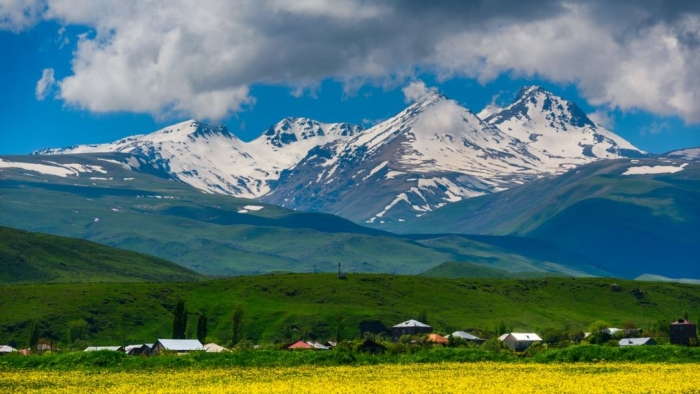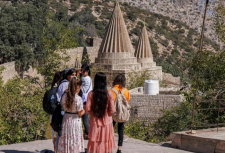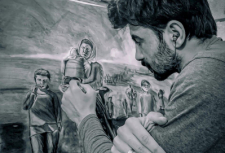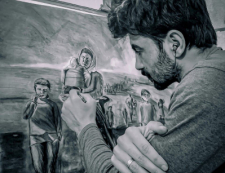Aragats – the mountain of the Yazidis

Every nation has special places connected with its history and life. For Yazidis in the first place, of course, were and will be mountains Sinjar (Shangal) in Iraq, where is the main Shrine of Yazidis — Lalesh temple.
The second most important place for thousands of Yazidis in the world, which is associated with the word homeland, in fact became the highest mountain of the Republic of Armenia – Aragats and its surroundings.
Aragats is an extinct volcano with a Grand crater, consists of 4 peaks, the highest — the Northern (4090 m), it is the highest point of the Republic of Armenia. Slightly below the Western peak (4007m), followed by the Eastern (3916m), and the southern (3879m) — the lowest of them. The crater of the volcano is located between these four peaks, its depth is 350m, and the width is 2.5 km.
On the slopes of Aragats come across not melting all summer snowfields and small glaciers. Closer to the peaks there are glacial lakes with the purest water, the largest of which – Kari – is located at an altitude of 3207 m above sea level.
Around the top of Aragats there is a vast mountain range with a perimeter of about 200 km. Aragats Massif is literally surrounded by a whole "scattering" of Yazidi villages. At the same time, mount Aragats, which gives birth to numerous streams and rivers, is not only an inexhaustible reservoir and source of water for a large part of the Republic of Armenia. Located on the slopes of Aragats mountain steppes and Alpine meadows are magnificent pastures.
"There and here in Aragats Scattered Parking Yazidis. As the grass on the lower pastures burns out, the herds rise higher and higher. At the end of July, shepherds with families reach the Alpine zone, where they live in canvas tents, from which protrude the smokestacks of bourgeoisie, fed by dung. Near the corrals placed bee hives. Some bee hives are made from the wreckage of school desks and kindergarten lockers: in some places you can see bears, squirrels, Chipollino and cherries" – writes about the traditional life of Yazidis magazine “Vokrug Sveta” ("Around the world") http://www.vokrugsveta.ru/vs/article/7632/.
The life of Yazidis families was well described in his blog by Armenian journalist Mark Grigoryan (markgrigorian.livejournal.com). With all the position and views of this journalist you cannot agree, but the main points of his story about the Yazidis give an idea about their traditional life on the nomads on the slopes of Aragats:
"The Said-Aga family, like many Yazidi families, expels flocks of sheep every spring to high mountain pastures, and every autumn brings them to winter in the lowlands. Pastures are located on the slopes of Aragats, and the Haloyans are proud that their camp is located at an altitude of more than 3000 meters, where the snow does not come down until mid-summer.
Haloyans live a semi-nomadic life long ago. Said Aga’s grandfather, Avet, worked for a while at a furniture factory in Yerevan in the seventies. Then life forced him to return to the ancient craft of the genus: sheep. "Every year around April 10 we take the sheep to the mountains and stay here until October 10-15. Then we return to the village, where we winter, and in April again go upstairs,"- says Avet.
It seems that everyone here knows what he needs to do. And sheep, cows and dogs seem to be quite consciously helping people. When the sheep are brought for milking, other sheep which will not be milked stay away for two hundred meters from the herd. The rest line up in a long submissive queue quite in the Soviet spirit, slowly moving to the paddock. Six and seven years old, Asew and Tina took the rods withdrawn cows who quietly obey these little ones....
Haloyan’s family lives in perfect harmony with the surrounding world. Here, where from the "benefits of civilization" only a kerosene lamp and a manual separator to separate milk from cream, there is no garbage – this is an integral part of our life. The waste is eaten by dogs and the paper isn’t used by people.
And time here flows differently than in the bustling civilized world: quietly, without fuss. There is no electricity in the camp, no newspapers, no radio or television. And the only people who bring information here are random guests like us.
"It's better here in the mountains than in the country, – says Mrav fourteen-year-old cousin of Said. – I love this free life: no one touches you, and you are your own master". Mrav, although he looks like an eleven-year-old boy, is already quite an adult member of the family responsible for grazing hundreds of lambs.
Unfortunately, this difficult, but corresponding to age-old traditions of Yazidis life on summer pastures is in the past. 2008 till 2010 were critical years – then, many Yazidis have sold their sheep and in the end were unable to restore the livestock. Having lost their earnings in their native villages, they were forced to go to cities or abroad.
Since then, herds of sheep on the slopes of Aragats have thinned. To get out of the cities to "rural" life can’t do everyone – although many dream about it. But still, Aragats with its magnificent pastures and clean spring water continues to be the "breadwinner" of hundreds of Yazidis, who, like their ancestors, every spring drive their herds into the mountains.
Translated by David Babaev
Yazidis.info
Tags:
Aragats – the mountain of the Yazidis

Every nation has special places connected with its history and life. For Yazidis in the first place, of course, were and will be mountains Sinjar (Shangal) in Iraq, where is the main Shrine of Yazidis — Lalesh temple.
The second most important place for thousands of Yazidis in the world, which is associated with the word homeland, in fact became the highest mountain of the Republic of Armenia – Aragats and its surroundings.
Aragats is an extinct volcano with a Grand crater, consists of 4 peaks, the highest — the Northern (4090 m), it is the highest point of the Republic of Armenia. Slightly below the Western peak (4007m), followed by the Eastern (3916m), and the southern (3879m) — the lowest of them. The crater of the volcano is located between these four peaks, its depth is 350m, and the width is 2.5 km.
On the slopes of Aragats come across not melting all summer snowfields and small glaciers. Closer to the peaks there are glacial lakes with the purest water, the largest of which – Kari – is located at an altitude of 3207 m above sea level.
Around the top of Aragats there is a vast mountain range with a perimeter of about 200 km. Aragats Massif is literally surrounded by a whole "scattering" of Yazidi villages. At the same time, mount Aragats, which gives birth to numerous streams and rivers, is not only an inexhaustible reservoir and source of water for a large part of the Republic of Armenia. Located on the slopes of Aragats mountain steppes and Alpine meadows are magnificent pastures.
"There and here in Aragats Scattered Parking Yazidis. As the grass on the lower pastures burns out, the herds rise higher and higher. At the end of July, shepherds with families reach the Alpine zone, where they live in canvas tents, from which protrude the smokestacks of bourgeoisie, fed by dung. Near the corrals placed bee hives. Some bee hives are made from the wreckage of school desks and kindergarten lockers: in some places you can see bears, squirrels, Chipollino and cherries" – writes about the traditional life of Yazidis magazine “Vokrug Sveta” ("Around the world") http://www.vokrugsveta.ru/vs/article/7632/.
The life of Yazidis families was well described in his blog by Armenian journalist Mark Grigoryan (markgrigorian.livejournal.com). With all the position and views of this journalist you cannot agree, but the main points of his story about the Yazidis give an idea about their traditional life on the nomads on the slopes of Aragats:
"The Said-Aga family, like many Yazidi families, expels flocks of sheep every spring to high mountain pastures, and every autumn brings them to winter in the lowlands. Pastures are located on the slopes of Aragats, and the Haloyans are proud that their camp is located at an altitude of more than 3000 meters, where the snow does not come down until mid-summer.
Haloyans live a semi-nomadic life long ago. Said Aga’s grandfather, Avet, worked for a while at a furniture factory in Yerevan in the seventies. Then life forced him to return to the ancient craft of the genus: sheep. "Every year around April 10 we take the sheep to the mountains and stay here until October 10-15. Then we return to the village, where we winter, and in April again go upstairs,"- says Avet.
It seems that everyone here knows what he needs to do. And sheep, cows and dogs seem to be quite consciously helping people. When the sheep are brought for milking, other sheep which will not be milked stay away for two hundred meters from the herd. The rest line up in a long submissive queue quite in the Soviet spirit, slowly moving to the paddock. Six and seven years old, Asew and Tina took the rods withdrawn cows who quietly obey these little ones....
Haloyan’s family lives in perfect harmony with the surrounding world. Here, where from the "benefits of civilization" only a kerosene lamp and a manual separator to separate milk from cream, there is no garbage – this is an integral part of our life. The waste is eaten by dogs and the paper isn’t used by people.
And time here flows differently than in the bustling civilized world: quietly, without fuss. There is no electricity in the camp, no newspapers, no radio or television. And the only people who bring information here are random guests like us.
"It's better here in the mountains than in the country, – says Mrav fourteen-year-old cousin of Said. – I love this free life: no one touches you, and you are your own master". Mrav, although he looks like an eleven-year-old boy, is already quite an adult member of the family responsible for grazing hundreds of lambs.
Unfortunately, this difficult, but corresponding to age-old traditions of Yazidis life on summer pastures is in the past. 2008 till 2010 were critical years – then, many Yazidis have sold their sheep and in the end were unable to restore the livestock. Having lost their earnings in their native villages, they were forced to go to cities or abroad.
Since then, herds of sheep on the slopes of Aragats have thinned. To get out of the cities to "rural" life can’t do everyone – although many dream about it. But still, Aragats with its magnificent pastures and clean spring water continues to be the "breadwinner" of hundreds of Yazidis, who, like their ancestors, every spring drive their herds into the mountains.
Translated by David Babaev
Yazidis.info
Tags:


























